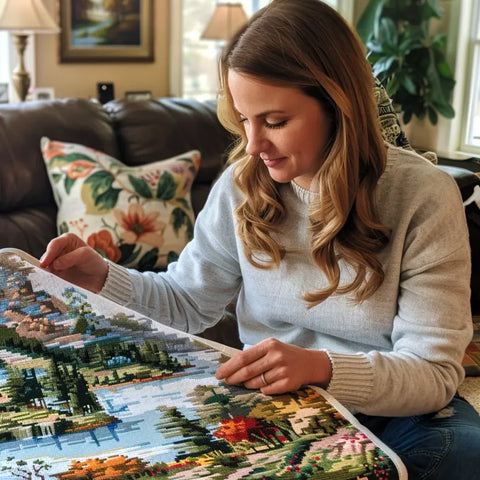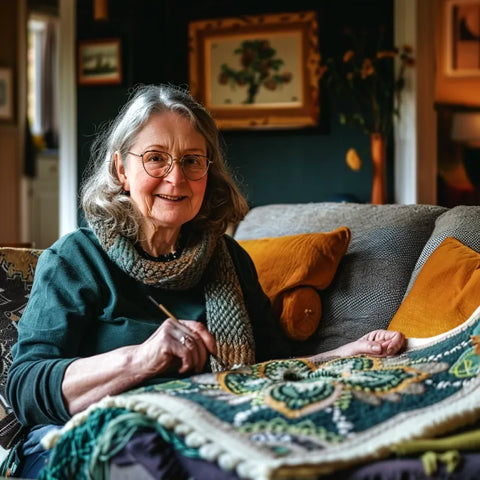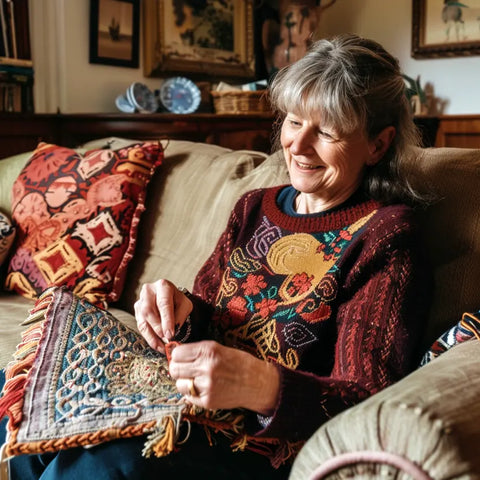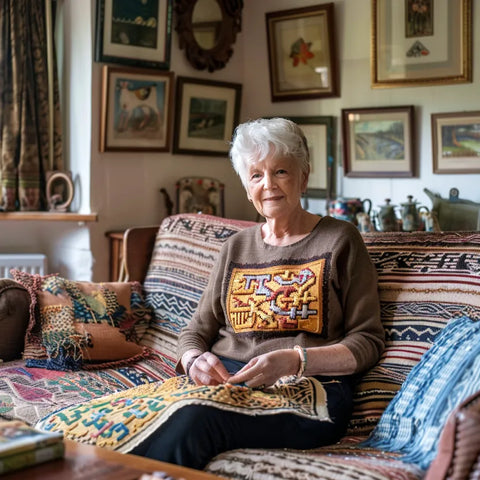Is Needlepoint the Same as Tapestry? 5 Key Differences

Feeling a bit bamboozled by the world of tapestry and needlepoint? Can't quite put your finger on the difference between the two?
Trust us, you're not alone! It's a common conundrum for many crafters, especially when you're just starting out and everything seems like a tangled mess of threads.
But fear not! We've all been there, scratching our heads and wondering where to begin.
The good news is, once you unravel the mystery, you'll be stitching like a pro in no time. So, let's dive in and explore the five key differences between needlepoint and tapestry, shall we?
1: Canvas vs. Fabric: The Foundation of Your Masterpiece
When it comes to the foundation of your project, needlepoint and tapestry couldn't be more different. Needlepoint is all about that stiff, open-weave canvas, like a blank slate waiting for your creative touch.
You've got your mono canvas, with its single thread, and your Penelope canvas, with a double thread for a bit more heft. It's like choosing between a classic vanilla and a rich, indulgent double chocolate, but for your stitching pleasure.
On the other side of the spectrum, tapestry is all about that tightly woven fabric, usually made of linen, cotton, or wool. It's like a cosy, snug sweater that hugs your stitches tight.
Fabric choice makes a world of difference in the final look and feel of your project, so choose wisely!
2: Stitches That Make Your Heart Sing
Now, let's talk about the nitty-gritty of stitching.
The stitching techniques used in needlepoint and tapestry create texture and depth, bringing your designs to life.
In needlepoint, the tent stitch family reigns supreme, with basket weave, continental, and half-cross stitches as your trusty companions. These stitches work together to create a smooth, even surface that's a delight to behold and a joy to touch. It's like a dance of the needle, with each stitch playing its part.
Tapestry, on the other hand, likes to mix things up with a variety of stitches. You've got your slit stitch, your dovetail stitch, and your interlocking stitch, all adding their own unique flair to the finished product. It's like a stitching buffet, with each technique bringing something special to the table.
3: Thread and Yarn: The Fibres of Your Dreams

When it comes to the materials you use, needlepoint and tapestry are like night and day. Needlepoint is all about that delicate touch, with wool, silk, or cotton thread as its go-to.
It's like working with strands of gossamer, each one finer than the last. You might even use multiple strands to get that perfect coverage, like a little thread party on your canvas.
Tapestry, on the other hand, is all about that thick, luscious wool yarn. It's like working with strands of pure, cosy comfort. The thicker yarn means better coverage and durability, perfect for those heirloom pieces that'll stand the test of time.
4: Design Decisions: Intricate Details or Bold Statements?
When it comes to design, needlepoint is like the intricate, detailed beauty of a fine painting. You've got your shading, your colour blending, all working together to create a stunning, lifelike image.
It's like a stitched version of a masterpiece, with each tiny stitch playing its part. Designs are often charted or hand-painted on the canvas, like a roadmap for your needle.
Tapestry, on the other hand, is like a bold, graphic statement piece. It's all about those big, chunky blocks of colour and stylised designs.
It's like a stitched version of a modern art piece, with each colour and shape making a bold statement.
The designs are often created as the weaving progresses, like a freeform jazz composition of colour and texture.
5: Finished Projects: From Pillow Talk to Wall-Worthy Wonders

Needlepoint and tapestry have different destinies in store. Needlepoint is like the icing on the cake of your home décor, with pillows, wall hangings, and accessories all sporting its intricate, detailed beauty. It's like a little touch of elegance, framed or stand-alone, ready to be admired.
Tapestry, often referred to as "woven art," is destined for grander things. These large-scale wall hangings and artistic displays are like a love letter to your home décor, with each stitch a whisper of your creativity and passion.
When you make this woven artwork, it can capture different things like historical events, beautiful scenes, or abstract designs. People will want to talk about it, and it'll be something special that your family will keep for many generations.
Materials and Tools: Your Creative Arsenal
Now, let's talk about the tools of the trade.
For needlepoint, you'll need your trusty canvas, needles, threads, scissors, and frames. It's like a little sewing kit in a compact, portable package. For some tapestry, you'll be working with looms, bobbins, shuttles, and both weft and warp yarn.
It's like a mini weaving studio, with each tool playing its part in the creation of your masterpiece.
If you're just starting out, don't worry! There are plenty of beginner-friendly options out there, like tapestry kits that come with everything you need to get started. And when you're ready to take your craft to the next level, investing in high-quality materials can make all the difference.
Skill Level: From Beginner to Master Stitcher
Now, let's talk about the skill level required for each craft. Needlepoint is often considered a bit easier for beginners, like a gentle stroll in the park of stitching. With some perseverance and dedication, you'll soon be sewing like a professional.
Tapestry, on the other hand, can be a bit more challenging, like a hike up a steep mountain of stitching. But don't let that discourage you! With the right resources, like online tutorials, classes, and workshops, you'll be scaling those stitching peaks in no time.
And don't forget about books, magazines, and patterns, like a treasure trove of stitching knowledge at your fingertips.
The key is to start simple and work your way up. Choose a project that's just challenging enough to keep you engaged, but not so difficult that you get discouraged.
And remember, every stitch is a step towards mastery!
Care and Maintenance: Preserving Your Stitched Treasures
Finally, let's talk about taking care of your finished projects. Needlepoint and tapestry are delicate, precious treasures that deserve the royal treatment. With proper care and maintenance, they'll stay beautiful for years to come.
For needlepoint, gentle cleaning techniques and storage solutions are key. You might even consider framing your finished pieces, like a little needlepoint art gallery in your home. For tapestry, hanging solutions and regular maintenance will keep your pieces looking their best.
And don't forget, a little TLC goes a long way towards preserving the longevity of your crafted items. With the right care, your needlepoint and tapestry masterpieces will be enjoyed for generations to come.
Your Stitching Adventure Awaits: Embrace the Journey

Feeling inspired to dive into the world of tapestry and needlepoint? We hope you're buzzing with excitement, but a tad overwhelmed too.
It's like standing at the edge of a vast ocean of stitching possibilities, wondering where to dip your toes first.
But hey, you've got this! Armed with your newfound knowledge of the key differences between these two crafts, you're ready to embark on a thrilling creative journey. Picture the joy and happiness you'll have when you see your first tapestry. You'll make it stitch by stitch. It'll be beautiful and colourful.
So go ahead, grab your tools, and let your creativity soar. The world of tapestry and needlepoint is waiting to be explored, and you're the intrepid adventurer ready to conquer it all!
And take a look at our tapestry kits. We have kits for beginners, all the way up to advanced!
Your Burning Questions Answered: Needlepoint and Tapestry Demystified
What is the difference between needlepoint and tapestry?
Needlepoint and tapestry are like two peas in a pod, but with their own unique personalities. Needlepoint is the detail-oriented sibling, with its intricate designs and delicate threads, while tapestry is the bold and daring one, with its chunky yarns and grand, sweeping statements. It's like comparing a finely crafted piece of jewellery to a show-stopping, oversized sculpture – both beautiful in their own way, but with distinct characteristics that set them apart.
What is needlepoint also called?
Needlepoint, the crafty chameleon, goes by many names. You might hear it referred to as "canvas work" or "tapestry work," but don't be fooled – it's still the same beloved craft, just wearing a different hat. It's like a superhero with multiple secret identities, ready to swoop in and save the day with its trusty needle and thread.
What is another name for needle point?
Needlepoint, the master of disguise, is also known as "petit point" or "canvas embroidery." It's like a secret agent, taking on different aliases to keep things interesting. But no matter what name it goes by, needlepoint is always ready to create stunning, intricate designs that will make your heart skip a beat.
What stitch do you use for tapestry?
Tapestry, the stitch wizard, has a few tricks up its sleeve. The most common stitch used in tapestry is the half-cross stitch, also known as the tent stitch. It's like the trusty sidekick of the tapestry world, always there to lend a helping hand.
But tapestry isn't afraid to mix things up, with slit stitch, dovetail stitch, and interlocking stitch all making appearances, like a cast of colourful characters in a grand, woven tale.
20 Interesting Facts about Needlepoint and Tapestry
- Needlepoint is a form of embroidery that uses a small, flat needle to create a design on a fabric canvas.
- Tapestry, on the other hand, is a form of weaving in which the design is created by weaving different coloured threads into a larger fabric.
- Both needlepoint and tapestry have been used as a form of decorative art for centuries, dating back to Ancient Egypt and Greece.
- The earliest known example of needlepoint can be traced back to the 6th century BCE in Egypt.
- Tapestry has a longer history, with evidence of its use dating back to at least the 3rd century CE in China.
- Needlepoint was popularised in Europe during the 16th century, particularly in England and France.
- One of the most famous tapestries in the world is the Bayeux Tapestry, which depicts the events leading up to the Norman conquest of England in 1066.
- Tapestry became particularly popular during the Middle Ages and Renaissance period, with many churches and castles commissioning elaborate tapestries to decorate their walls.
- In the 19th century, needlepoint became popular among upper-class women as a creative and decorative hobby.
- Tapestry weaving requires extensive skill and training, while needlepoint can be learned and practiced by anyone with basic embroidery skills.
- Tapestry often uses more complex and intricate designs, while needlepoint designs tend to be simpler and more geometric.
- Tapestry is typically done on a larger scale, while needlepoint pieces are usually smaller and easier to transport.
- Both needlepoint and tapestry can be made using various materials, including wool, silk, and cotton thread.
- The famous Bayeux Tapestry is over 70 metres long and contains 58 separate scenes.
- The largest known needlepoint project is the Bayeux Tapestry replica in Reading, England, which took over 27 years to complete.
- In the 19th century, needlepoint was used as a form of therapy for soldiers returning from war. It allowed them to express themselves creatively and helped with their rehabilitation.
- Tapestry weaving is recognised as a UNESCO Intangible Cultural Heritage of Humanity. It represents a centuries-old tradition and requires specialised skills passed down from generation to generation.
- In the 20th century, needlepoint experienced a surge in popularity, with many modern artists incorporating it into their work and creating contemporary designs.
- Both needlepoint and tapestry have been used as a form of storytelling and historical record-keeping, with many pieces depicting important events or cultural traditions.
- Needlepoint and tapestry are still popular ways to make beautiful artwork. People enjoy making these detailed designs by hand.
